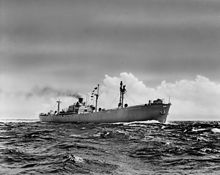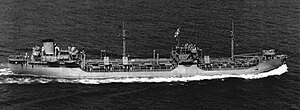World War II United States Merchant Navy
To make a Normandy breakwater Harbor, called Mulberry harbour, 33 merchant ships were sunk 1,000 yards from shore.
The 144,857 strong Navy Armed Guards also operated the radio, semaphore-signal flags, and the signal lamp.
[14][15][16] The men of our American Merchant Marine have pushed through despite the perils of the submarine, the dive bomber and the surface raider.
They have returned voluntarily to their jobs at sea again and again, because they realized that the life-lines to our battle fronts would be broken if they did not carry out their vital part in this global war.
Merchant Marine were killed at a per capita rate much higher than those of the combined United States Armed Forces.
[19] The greatest loss was in the Battle of the Atlantic due to U-boat torpedo or deck gun attacks.
Convoy system with destroyers, escort carriers, submarine chasers, planes and other support, reduced losses by 1944.
[34] Some of the US Merchant Navy continued in post-war relief efforts and general cargo shipping to help nations around the world recover from the devastating war.
Seagoing cowboys use cargo ships with added cages and horse stalls to take livestock to war-torn nations.
[56] American steamship companies operating merchant ships in World War II:[57] American steamship companies operating merchant tanker ships in World War II:[57]







